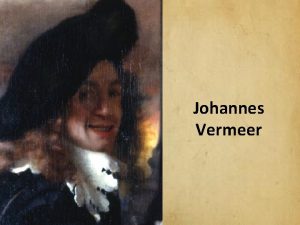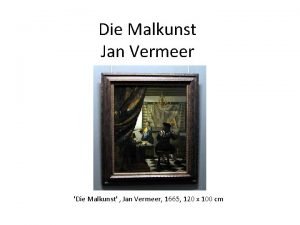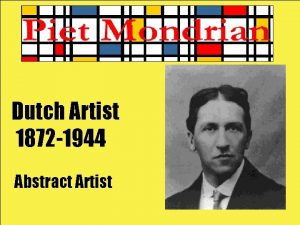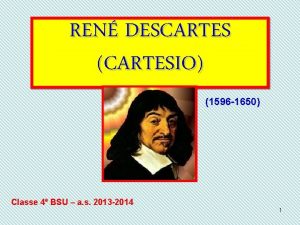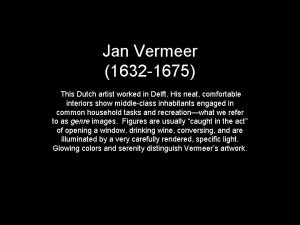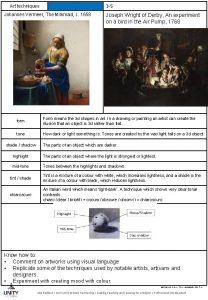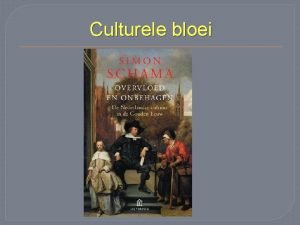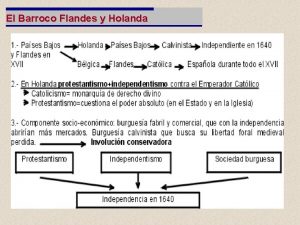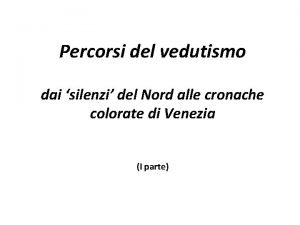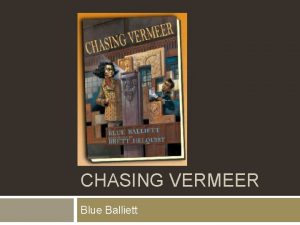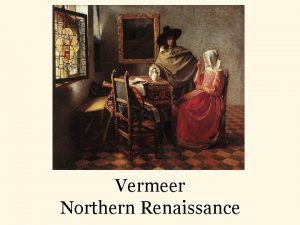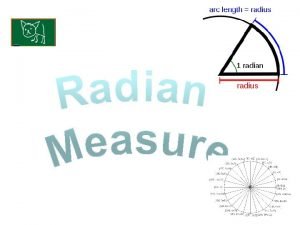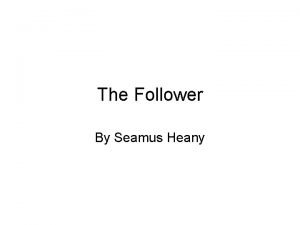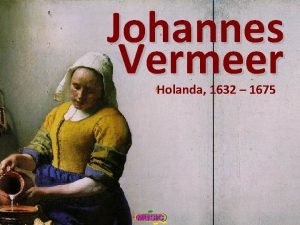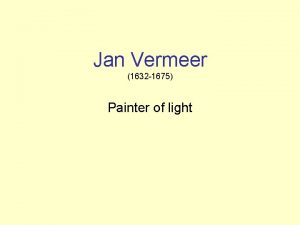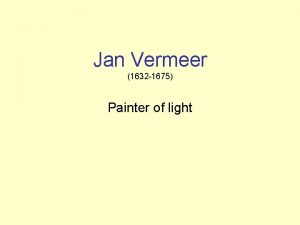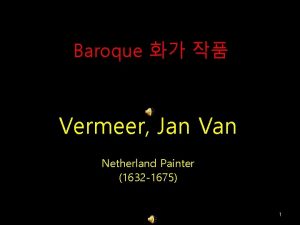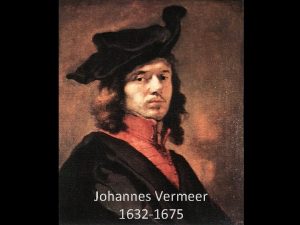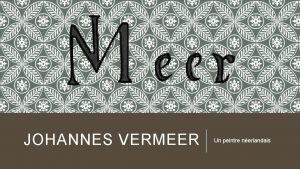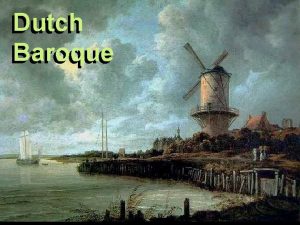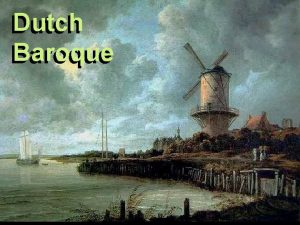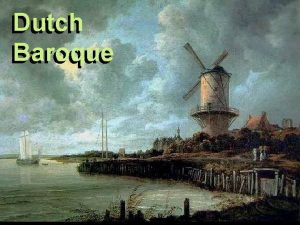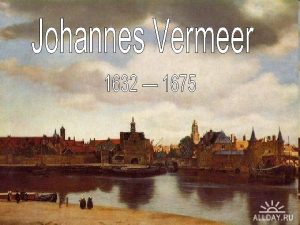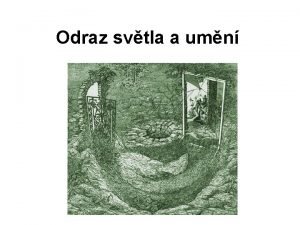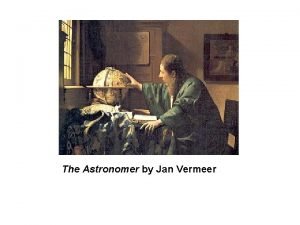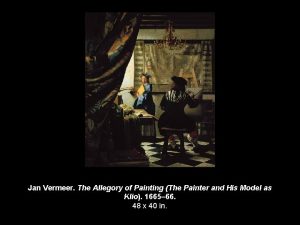Jan Vermeer 1632 1675 This Dutch artist worked






























- Slides: 30

Jan Vermeer (1632 -1675) This Dutch artist worked in Delft. His neat, comfortable interiors show middle-class inhabitants engaged in common household tasks and recreation—what we refer to as genre images. Figures are usually “caught in the act” of opening a window, drinking wine, conversing, and are illuminated by a very carefully rendered, specific light. Glowing colors and serenity distinguish Vermeer’s artwork.

Jan Vermeer (1632 -1675) View of Delft, Oil on Canvas

Jan Vermeer (1632 -1675) Woman Holding a Balance Oil on Canvas 1664 16. 75 x 15”

Jan Vermeer (1632 -1675) Allegory of the Art of Painting Oil on Canvas 1665 47 x 39” It is possible that Vermeer created his images using a camera obscura.

The camera obscura is an enclosed box with a lens built into a round window. The light of a bright image passes through the lens and is projected upside-down on the opposite wall. An artist may trace the projection to create an art image.

The camera obscura is an enclosed box with a lens built into a round window. The light of a bright image passes through the lens and is projected upside-down on the opposite wall. An artist may trace the projection to create an art image.


Jan Vermeer (1632 -1675) The Milkmaid Oil on Canvas 1658 18 x 16”

Jan Vermeer (1632 -1675) Officer and Laughing Girl Oil on Canvas 1658 20 x 18”

Jan Vermeer (1632 -1675) Young Woman with a Water Jug Oil on Canvas 1664 18 x 16”

Jan Vermeer (1632 -1675) Oil on Canvas

The Baroque in Spain’s close contacts with Italy and the Netherlands during the sixteenth century kept Spanish artists familiar with the main trends in European art. Painting dominated Spanish art during this period.

(detail from Las Meninas) Velazquez was the greatest Spanish artist of the period. He was appointed court painter by King Philip IV, and concentrated mainly on portrait work. His pictures tend to appear more realistic than his Spanish contemporaries. The images include a strong consideration of light, texture, and personal character. His painting technique became very economical and expressive over time.

Las Meninas Oil on canvas 1656 125 x 108” The painter shows himself standing in the studio in front of a very large canvas. In the foreground is the five year old princess with her two servants, two favorite dwarfs and a large dog. One dwarf is poking the dog with his foot. In the back of the room we see a mirror reflection of the King and Queen, whose portraits are being painted as we watch.

Diego Velazquez (1599 -1660) Las Meninas detail

(1599 -1660) Las Meninas (Detail) Oil on canvas, 1656 125 x 108” The artist may be painting this very picture or perhaps the portraits of the king and queen, whose reflections are seen in the mirror on the far wall in the middle of the composition. The artist’s aim is to show the movement of light and the countless ways it can be reflected. Notice the effect of light on form and color in the painting. The indirect light in the spacious studio contrasts with the direct light striking the figures in the foreground, bouncing and reflecting from a variety of materials. Line was rarely used by Velazquez.

Diego Velazquez (1599 -1660) King Philip IV 1644 Oil on canvas

Diego Velazquez (1599 -1660) Infanta Maria Teresa Oil on canvas

Diego Velazquez (1599 -1660) Pope Innocent X Oli on canvas 1650 55 x 45”

Diego Velazquez (1599 -1660) Los Borrachos 1628 Oil on canvas 66” x 90” As in the artwork of Caravaggio, it was typical for Velazquez to employ common local people as models—despite the mythological subject matter of this painting.

Diego Velazquez (1599 -1660) The Buffoon D. Sebastian de Morra This man suffers physical deformities beyond his control, but his eyes express an intelligence and humanity which might challenge his role as court buffoon.

Diego Velazquez (1599 -1660) Calabazas Oil on canvas, 1639 This man was a court jester, who was likely mentally impaired.

Diego Velazquez (1599 -1660) Venus and Cupid, 48 x 70” Oil on canvas, 1648 In addition to the delicate, realistic portrayal of light and various textures, notice how the artist uses cool colors against warm colors to create a lively image.

Francisco Zurbaran (15981664) Spanish Saint Francis in Meditation, 1639 Oil on canvas 75 x 54” His best known paintings are those of saints in devotional attitudes, sharply lit from one side, within a darkened space. His use of tenebrism shows the influence of Caravaggio.

Francisco Zurbaran (1598 -1664) Saint Francis in Meditation, 1635 Oil on canvas 60 x 39” Zurbaran’s work is known for its strong use of tenebrism, which demonstrates that this Spanish artist was clearly influenced by the work of Caravaggio.

Francisco Zurbaran (15981664) St. Serapion Oil, on canvas 1628 48 x 41”

Francisco Zurbaran (1598 -1664) Spanish

Francisco Zurbaran (1598 -1664) Spanish

Bartolome Estaban Murillo (1617 -1682) Immaculate Conception 1660 -70, Oil on canvas 6’ 9” x 4’ 8” His large workshop in Seville, Spain, produced many canvases of the Virgin Mary, shown in a popular, sentimental style.

real window opening beyond the wall where it hangs on display. The picture plane is parallel to the wall, the woman’s elbow rests on its ledge, and the shutter draws the viewer’s eye right back into the imaginary space. Contrasting values is an essential ingredient in this picture, as the women emerge from the dark surroundings and advance toward the viewer.
 Jan vermeer van delft catharina bolnes
Jan vermeer van delft catharina bolnes Jóban rosszban 1675
Jóban rosszban 1675 Ivo ihrke
Ivo ihrke Jan vermeer die malkunst
Jan vermeer die malkunst Dutch abstract artist
Dutch abstract artist Vermeer alegoria malarstwa
Vermeer alegoria malarstwa Vermeer műterem
Vermeer műterem Potosí
Potosí La la laitiere weed
La la laitiere weed I bevitori velazquez
I bevitori velazquez Herman vermeer
Herman vermeer _vti_cnf exploit
_vti_cnf exploit Vestbulo
Vestbulo Herman vermeer
Herman vermeer Johannes vermeer kenmerken
Johannes vermeer kenmerken Johannes vermeer barroco
Johannes vermeer barroco Vermeer piano
Vermeer piano Chasing vermeer chapter summaries
Chasing vermeer chapter summaries Vermeer renaissance
Vermeer renaissance Essays that worked johns hopkins
Essays that worked johns hopkins She worked hard. she made herself ill
She worked hard. she made herself ill How to find area of a sector with radians
How to find area of a sector with radians Hobnailed wake
Hobnailed wake Worked out
Worked out Calorimetry 2 chemsheets answers
Calorimetry 2 chemsheets answers Prime mover for arm extension
Prime mover for arm extension The muscular system
The muscular system Guillaume de machaut worked primarily in
Guillaume de machaut worked primarily in Indirect speech
Indirect speech Condition type 3
Condition type 3 Orthogonal array
Orthogonal array
